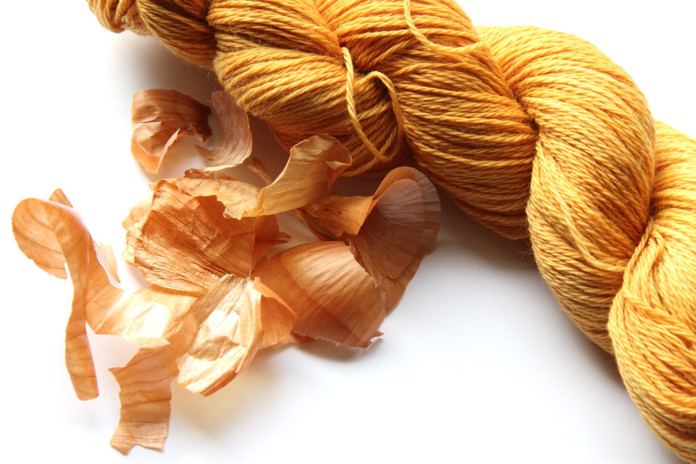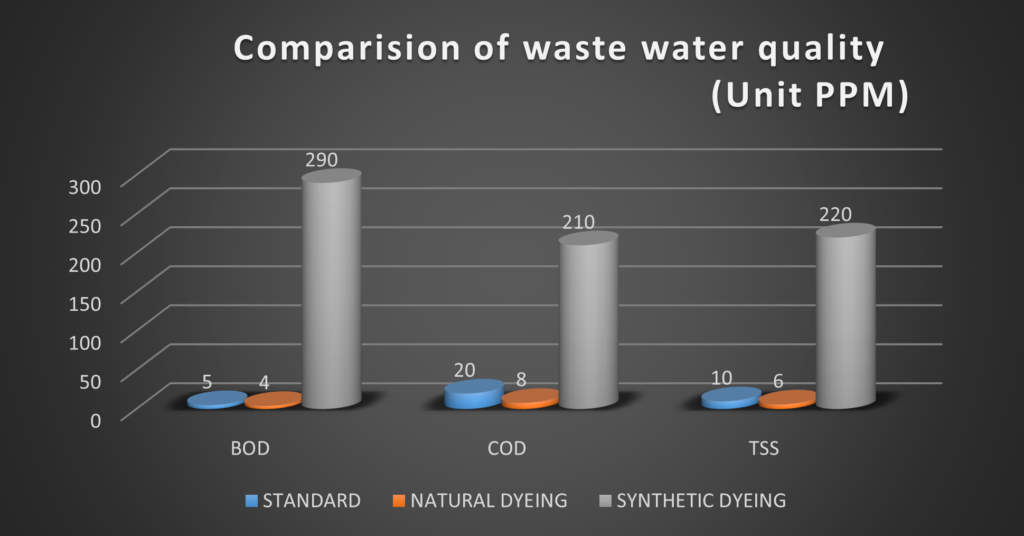India can achieve a big portion of its sustainable development goals by taking up natural dye cultivation even in waste and arid lands. This will also help generate employment and prevent dumping of effluents into water bodies, argues Dr. Mazahir Raza, Chartered Scientist Technical Director, R&D Centre, AMA Herbal Laboratories
Since natural dyes are almost 100% biodegradable and sustainable leading textile brands are developing their products dyed in natural dyes. To meet the growing demand and to become price competitive against harmful synthetic dyes there is big need to increase production of natural dyes.
The huge demand can be met either by hybrid or Genetically-Modified Natural Dyes. When land availability is a major limiting factor the needs of the hour is to create crops that require less space to grow. According to VIB, a Belgian research institute, cultivation of GM crops over the last 18 years has delivered substantial benefits for the environment.
Insect-resistant crops have resulted in a 230 million kg decrease in the use of insecticides. Herbicide-tolerant crops have led to reductions in fuel use and CO2 emissions of 6.3 billion liters and 16.8 million metric tons respectively, by supporting no-till farming. Overall, GM crops have produced an environmental benefit of 37%.
Crossbreeding hybrids, which is a centuries-old method, the coloring molecule in the plant can be increased. This will reduce the consumption of raw material in the manufacturing of natural dyes.
Availability of all types of dye-bearing plants can also be increased by working on wild variety growing on wastelands and marginal lands. If we focus on increasing production of natural dyes in a sustainable manner from agri-waste or byproduct of any industry where vegetable matter is used as raw material, for example, food, pharmaceuticals, leather, furniture and lacquer industry demand of dye houses can be met.
By application of biotechnological tools including cell and tissue cultures, genetic engineering produces quantity and quality of raw material for natural dyes can be regulated.
Testing Challenges – Tag Separately
There is a myth that reproducibility of shade is not possible in dyeing with natural dyes. If dyeing with natural dyes is compared with synthetic dyes, dyer can see in dyeing with whether natural or synthetic the challenges are same but since synthetic dyes are highly purified the problems are overcome relatively easily than natural dyes.
Synthetic dyes molecule is made compatible with the substrate for cotton there are reactive dyes, wool acid dyes, polyester disperse dyes and so on but in case of natural dyes cotton, silk, wool, jute whatever substrate is dyed with same dye. For example, Mallow the natural dye from pomegranate gives yellow on cotton and khaki on wool. Even single natural dye gives different shades of different tones on the same substrate by using different pre and post treatments of the substrate.
Quality control of synthetic dyes is done in compliance with international standards mainly AATCC and ISO. The dyed substance has to meet required good fastness rating as per standards. When checked on existing colorfastness testing methods almost all-natural dyes fail especially for wash and light fastness. Chromophores of natural dyes are weak which make fastness poor but natural dyes if processed properly, can match color fastness properties as good as synthetic dyes. There is a demand for sustainable textile with natural dyes but brands are not showing any aggression for promoting their natural dyed products.
Actually, the problem is in the testing methods of existing standards not in natural dye. Most of the natural dyes are pH sensitive. It is observed that when the naturally-dyed textile sample is tested as per AATCC and ISO for fastness shades not became lighter but tonal change appeared.
Separate standards must be made for natural dyes. This is the need of the hour. Without delay, AATCC and ISO must establish testing standard keeping in mind the properties of natural dyes. May the world think it is ridiculous but the only solution is that naturally-dyed products should be tagged properly with special washing and drying instructions.
What the Fashion Industry can Do
The fashion designers are the ringmasters for a consumer. Textile to apparel designer plays a vital role. Colors make the design attractive. Fashion designers can play an important role by making sure that their products are dyed or printed with natural dyes in the most environmentally friendly way possible. With the realization of the unsustainable and hugely exploitative nature of the fashion industry, designers want ‘sustainable fashion’ for the world. Here too natural dyes are facing challenges. Limited shade range puts designers in a challenging position. They hesitate to step into eco-fashion but colors on textile dyed with natural dyes have their own beauty hue is soft and earthy.
Today designers make their designs with shades available and achievable from synthetic dyes. Any intensity of color can be gained by synthetic dyes which are so far not possible with natural dyes. Making the dyeing process of their garments is indeed one of the hardest nuts to crack for eco-conscious brands. Many of them dive into natural dyes nowadays: a good reason to take a closer look at this process.
If the fashion world really wants to produce sustainable textile and other product dyed with natural dyes designers should try to find more colors. A good range of shades can be produced by intermixing and overdyeing different dyestuff such as Bio Indigo, Kareel, Rubia, Mallow, etc.
There is a need for a separate regulatory body for natural dyes. Natural dyes manufacturers should be forced to follow the guidelines.
Today when people need clothing with antibacterial /antiviral effect to protect us from Covid 19. Copper is the best natural antibacterial /antiviral agent available. But antibacterial /antiviral activity of copper can be gained when it is used far above RSL limits.
A majority of dyeing houses are in developing countries. So the use of natural dyes will definitely give momentum to the economy of such nations. Natural Dyes can provide sustainable livelihoods for the agriculturists, it can make textile industries more competitive and healthier, by reducing production costs by eliminating the huge expenses of effluent treatment.
The expanding premium market for goods that carry ‘natural’ or ‘eco-safe’ or ‘green’ or similar labels is providing an excellent focal point for the textile industry. Highly biodegradable and nontoxic properties of natural dyes offer textile coloration the maximum scope for capitalizing on the eco-conservation. Sustainable textile products can be produced only by returning of natural dyes on a commercial scale.
Dye manufacturing companies are now focusing on production as well as novel technologies for making natural dyes as a compatible and eco-safe alternative to synthetic dyes. This will help in sustainable development of the textile world and make this earth greener.
How Natural Dyes are Sustainable
Unlike petroleum resources, natural dyes are obtained from natural resource are completely renewable as well as biodegradable. Natural dyes are prepared from dried plant material such as fruits, leaves, flowers, seeds, and rhizomes. Most of the time these dried plant materials. Some natural dyes such as Bio Indigo or Natural Indigo are obtained from annual crops.
Some natural dyes are obtained from bark and wood. These are not considered as sustainable sources because it is difficult to remove these without harming trees. This issue can be addressed by procuring bark and wood as a by-product from the timber industry. There are several agro-processing wastes such as pomegranate rind, onion peel is used to color textile and flowers offered in temples are the source of natural dyes.
Lac mud which is an industrial waste of the shellac-manufacturing industries is a cheap source of lac dye. When we use these resources for procuring raw material for natural dyes, we follow Triple Bottom Line (TBL) which is also known 3Ps: people, planet, and profits. It is the essence of sustainability.
In comparison with synthetic dyes, natural dyes are found eco-friendlier on the basis of Life Cycle Analysis (LCA). For example, LCA of Bio Indigo (Natural Indigo)
| Impact Categories | Natural Indigo/ BioIndigo Dye | Synthetic Indigo Dye | % Difference |
| Acidification Potential (AP)[kg SO2 eq.] | 3.56E-02 | 4.21E-02 | 15.55 |
| Eutrophication Potential (EP) [kg Phosphate eq. | 3.35E-02 | 3.14E-02 | 1.93 |
| Global Warming Potential (GWP100 years)[kg CO2 eq] | 8.09 | 9.03 | 9.28 |
| Photochem Ozone Creation Potential (POCP) [kg ethane eq] | 1.80E-03 | 2.26E-03 | 20.08 |
| Primary energy demand (net cal.value) [MJ] | 209.39 | 227.69 | 8.04 |
| Eco toxicity Potential [CTUe] | 0.73 | 0.95 | 22.62 |
| Human toxicity Potential [CTUh] | 3.08E-11 | 3.60E-11 | 14.39 |
| Blue water consumption [kg] | 2984.8 | 2973.40 | -0.38 |
Table 1 – Comparison of LCIA results of dyeing with Natural indigo/Bio Indigo vs Synthetic Indigo Dye
| Impact Categories | Natural Indigo/ BioIndigo Dye | Synthetic Indigo Dye | % Difference |
| Acidification Potential (AP)[kg SO2 eq.] | 0.12 | 0.25 | 51.88 |
| Eutrophication Potential (EP) [kg Phosphate eq. | 0.02 | 0.05 | 61.30 |
| Global Warming Potential (GWP100 years)[kg CO2 eq] | -0.69 | 10.38 | >100 |
| Photochem Ozone Creation Potential (POCP) [kg ethane eq] | -3.79E-03 | 2.90E-03 | >100 |
| Primary energy demand (net cal.value) [MJ] | 78.61 | 200.25 | 60.74 |
| Eco toxicity Potential [CTUe] | 4.00E-03 | 1.78E-02 | 77.53 |
| Human toxicity Potential [CTUh] | 1.69E-11 | 1.88E-11 | 10.26 |
| Blue water consumption [kg] | 706.16 | 44.06 | >100 |
Table 2 – Cradle to gate LCIA results of 1 kg of Natural indigo/Bio Indigo vs Synthetic Indigo Dye manufactured
When a comparison was made between Cradle to gate of 1 kg of Natural Indigo dye and 1 kg of Synthetic it was observed that Natural Indigo had more than 50% lesser impact. This reinforces the statement that better utilization of Natural Indigo in the textile sector will have more savings potential.
Easy-to-Treat Effluent
Natural dyes are derived from natural materials are susceptible to microbial action. This makes it 100 % biodegradable. In comparison to synthetic dyes, the dye molecule of natural dye has low tinctorial value. Thus, natural dyes are more susceptible to the action of light and water than a synthetic one. Effluent produced during its dying is easily treatable and less expensive than received form synthetic dyes
Natural dyes are available in nature with various hues and tones. Natural dyes are basically extracts of plant materials, mainly from fruit, flower, bark, and leaves. The phytochemicals present in natural dyes impart antioxidant, antibacterial, antimicrobial, antifungal properties. This makes the textile dyed with natural dyes skin friendly for consumers. The modern trend of Ayur Vastra claims that the clothing dyed with natural dye can cure skin ailments over a period of time.
Email – mraza@amaherbal.com












